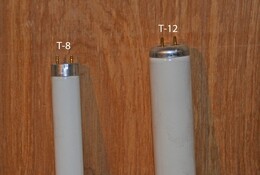
So, does a smaller diameter mean less light? Not at all. In fact, the T-5 can be the brightest of the three. Another advantage for these newer lamps is they use less electricity per lumen. The traditional 48-inch T-12 is rated at 40 watts. However, there are newer styles of T-12's that are 34 watts. The T-8 is rated at 32 watts and the T-5 at 28 watts.
This sounds too good to be true. Are there drawbacks? Maybe so or maybe not. First is cost if you have to replace T-12 fixtures to convert to a T-8 system. However, newer fixtures may be able to handle either T-12's or T-8's. Therefore, if you purchased fluorescent fixtures in the last few years, check to see if they are rated for T-8's before replacing them. Note that lamp costs are comparable between T-12's and T-8's. The T-5 lamps may be more expensive so check prices before converting.
The question becomes, is it worth it? If you have a T-12 fixture that is rated for T-12's only and are satisfied with your results, then maybe not. However, if you are investing in new fixtures or have fixtures that can use either T-12's or T-8's, then go with the T-8's. They will use less energy, last longer and provide more light. Prices for T-5's have been dropping so you may want to consider them as well.
The newest technology is LED lighting. LED’s have several advantages over other types of lighting including durability, long life, a cool running temperature and more latitude in choosing specific wavelengths of light. Traditionally, they have been very expensive but costs are dropping rapidly. We are starting to use LED’s as supplemental lighting in the University greenhouses but would suggest only using them on a trial basis at home until you see how they perform for you. (Ward Upham)
 RSS Feed
RSS Feed
